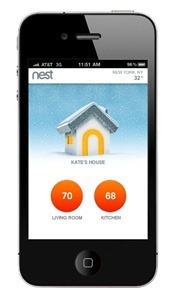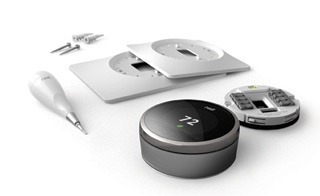Many years ago, Tony Fadell took an idea he had for a new gadget to Apple. It was a pocket-sized hard-disk MP3 player. Apple was impressed–and, just over a decade ago, released Fadell’s creation as the iPod. It was, as you may recall, quite popular.
(MORE: The iPod Turns 10: How It Shaped Music History)
Fadell went on to run Apple’s iPod division, but in 2008, he stepped down and in 2010, he severed all ties with Apple. He and his wife (also a former Apple employee) spent some of their newly-found free time with their kids, and some of it building a green home near Lake Tahoe.
While Fadell was working on his house, he had a new brainstorm. Why not take the thermostat–one of the most boring devices on the planet, and therefore one which is largely ignored by most homeowners–and make it interesting? Why not make it what he calls “a cherished object?” Why not make it a gadget?
Inspired, he co-founded a company called Nest Labs. It’s announcing its creation, the Nest, which it plans to ship in November for $249. And it’s not just the least boring thermostat ever invented: It’s downright interesting. When Fadell briefed me recently and did a demo, I got excited by its potential–and if you see one in person, I think you’ll be just as intrigued.
(MORE: 6 Things You’d Never Guess About Google’s Energy Use)
The Nest thermostat is in some ways reminiscent of the ancient one in my 1950s home–they’re both round, and let you control the temperature by rotating a ring. But it’s also radically different from any other thermostat you’ve ever seen, and almost explicitly evocative of the iPod, another gizmo you control by spinning a circular input device. (Fadell told me that he decided to pursue this idea in part because he promised Steve Jobs he wouldn’t compete with Apple, but his Apple experience practically exudes from the Nest nonetheless.)
Unlike most modern thermostats–which, if you’re lucky, have an LCD display, a few buttons, and rudimentary programming capabilities–the Nest is a sophisticated piece of consumer electronics. Inside the metal ring you spin to control it is a round color LCD. It’s also got Wi-Fi, allowing it to get onto the Internet. And it’s got embedded motion detectors, allowing it to have a sense of what’s going on around it.
article continues on next page…
Like any thermostat, the Nest lets you rotate to the left to turn the temperature down, and rotate to the right to crank it up. But that’s just the start. Here are some of the other things it does:
- It can pay attention to its surroundings and turn down the heat automatically when it notices you’re not around.
- As you adjust the temperature, it can pay attention, learn, and start to adjust it itself to mirror your habits.
- When you use it in an energy-saving manner, it shows a green leaf to let you know you’re doing good.
- It allows you to control it remotely over the Web or using an iOS app (an Android one is in the works).
- It makes its LCD turn blue when it’s cooling your home, and red when it’s heating it.
- When you set it to a particular temperature, it tells you how long it’ll be until it reaches it.
- It can nudge you out of your comfort zone ever so slightly–making thing a little cooler or a little hotter to save more energy.
- It can show the future temperature adjustments it’s programmed to make in a calendar view.
It’s hard to overstate how well-done Nest is, at least from a conceptual, interface, and industrial design standpoint. (I saw Fadell show off a version on a little demo stand, so I can’t vouch for how well it actually does at saving energy.) It looks good, it feels good, and it’s more intuitive to use than garden-variety thermostats that do far less. It seems remarkably polished for a first-generation product in a new category. (Fadell calls it the first learning thermostat.)
 Nest Labs plans to sell Nest through home-improvement stores, electronics shops such as Best Buy, and specialty merchants that cater to contractors and HVAC experts. It says that anyone who’s comfortable installing a light switch should be able to install the Nest in about twenty minutes: It comes with a special tool and faceplates that let you avoid spackling and painting if you want.
Nest Labs plans to sell Nest through home-improvement stores, electronics shops such as Best Buy, and specialty merchants that cater to contractors and HVAC experts. It says that anyone who’s comfortable installing a light switch should be able to install the Nest in about twenty minutes: It comes with a special tool and faceplates that let you avoid spackling and painting if you want.
Will it do well? Only if it changes the way people think about thermostats, which is usually not to think much about them at all. Based on what I’ve seen I think it has a good shot at being at least as important in its category as the iPod was in its field.
MORE: Ten of the Shortest-Lived Tech Products Ever
This post originally appeared on Technologizer…


